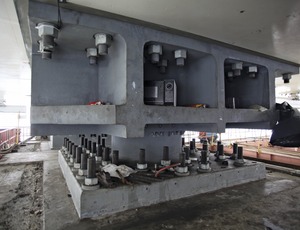

The Toll Bridge Program Oversight Committee, or TBPOC, says it has a plan in place to fix broken bolts on the $6.4-billion San Francisco-Oakland Bay Bridge project. It was revealed in March that 32 of the 96 anchor bolt rods on the structure's eastern span broke when crews tightened them.
The plan calls for the installation of custom-made steel saddles with hundreds of post-tension wires encased in concrete over two shear keys attached to the rods. TBPOC and main contractor American Bridge-Fluor Joint Venture say an equivalent amount of clamping force as the original bolt design's can be attained to hold down the shear keys.
The saddle fix will cost between $5 million and $10 million. While requiring detailed fabrication, it will be easier to install and need less coring of the concrete cap beam than an alternative, $20-million option using steel collars, says Andre Boutros, executive director of the California Transportation Commission.
Because the 3-in.-dia, 9- to 24-ft-long bolt rods already have been deeply embedded into concrete in inaccessible areas directly under the bridge decks, removing the bolts would be too costly and time-consuming, TBPOC says.
The committee also asked the Federal Highway Administration to conduct its own review of the problematic bolts and the saddle fix.
"They will make independent judgments, and I think that will provide a level of reassurance to the public and the [California] Legislature that we are getting to the right answers," said Steve Heminger, executive director of the Bay Area Toll Authority (BATA) and TBPOC chairman, at a briefing.
In a metallurgical testing analysis released by TBPOC, investigators found that the rods, which were fabricated in 2008, failed because of hydrogen embrittlement, which requires a source of hydrogen, susceptible material and tension. The report found the microstructure of the steel to be inhomogeneous, resulting in large hardness differences from center to edge and high local hardness near the surface.
"Hydrogen embrittlement is a form of corrosion in which hydrogen atoms enter into the structure of the metallic alloy and end up blocking the ability of the metal to deform easily when the part is loaded, particularly in tension," says Dr. Vilupanur Ravi, chairman of the chemical and materials engineering department at Cal Poly Pomona.
While the exact cause of the reaction is not yet known, BATA spokesman John Goodwin says hydrogen could have been introduced in the manufacturing or galvanizing process or during five years of external exposure to the Bay Area environment.
On Tuesday, the California State Senate Transportation and Housing Committee held a hearing where they grilled TBPOC representatives about the bolts and other problems. Committee chairman Mark DeSaulnier pressed Heminger and Caltrans director Malcolm Dougherty on why the galvanized bolts were used in the first place, since their use deviates from standard AASHTO bridge design specifications.
Dougherty replied that the design decision ws made in cooperation with a group of experts, including engineer-of-record T.Y. Lin, and that standard specifications are used on "everyday bridges, but to our engineers, this is not your everyday bridge."
“What we do know today that we did not incorporate then because we didn’t know, is the level of testing that we should do in ordering these bolts," Dougherty added. "The devil is not in the galvanizing; the devil is in the metal.”
Officials have not yet confirmed whether the bridge will open as scheduled on Labor Day weekend. Goodwin says other anchor rods made in 2010 appear to be safe but currently are undergoing destructive testing. All future batches will be subject to more rigorous testing, he adds.


Post a comment to this article
Report Abusive Comment